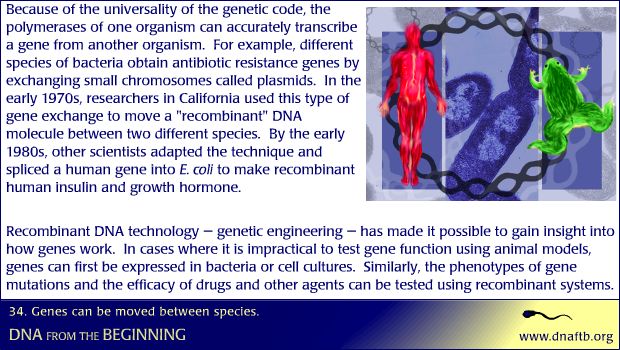Concept 34: Genes can be moved between species.

Recombinant DNA technology has made it possible to test gene function in bacteria or cell cultures rather than animal models.
Because of the universality of the genetic code, the polymerases of one organism can accurately transcribe a gene from another organism. For example, different species of bacteria obtain antibiotic resistance genes by exchanging small chromosomes called plasmids. In the early 1970s, researchers in California used this type of gene exchange to move a "recombinant" DNA molecule between two different species. By the early 1980s, other scientists adapted the technique and spliced a human gene into E. coli to make recombinant human insulin and growth hormone. Recombinant DNA technology — genetic engineering — has made it possible to gain insight into how genes work. In cases where it is impractical to test gene function using animal models, genes can first be expressed in bacteria or cell cultures. Similarly, the phenotypes of gene mutations and the efficacy of drugs and other agents can be tested using recombinant systems.
antibiotic resistance genes, recombinant dna technology, recombinant human insulin, different species of bacteria, dna molecule, species of bacteria, gene mutations, cell cultures, gene exchange, animal models, gene function, polymerases, genetic code, phenotypes, chromosomes, genetic engineering
- ID: 16704
- Source: DNALC.DNAFTB
Related Content
16705. Animation 34: Genes can be moved between species.
Stanley Cohen and Herbert Boyer transform bacteria with a recombinant plasmid, and Doug Hanahan studies induced transformation.
15476. Mechanism of Recombination, 3D animation with with basic narration
Genetic engineering: inserting new DNA into a plasmid vector.
16833. Concept 40: Living things share common genes.
All organisms store genetic information in DNA and RNA.
16856. Animation 41: DNA is only the beginning for understanding the human genome.
Mario Capecchi describes proteomics; the large-scale study of protein structure and function. Brian Sauer explains gene knock outs.
897. Gene knockout in mice
This method uses homologous recombination to disable a gene of interest to produce a genetic knockout.
548. Model Center
Model organisms share with humans many key biochemical and physiological functions that have been conserved (maintained) by evolution.
16834. Animation 40: Living things share common genes.
Mike Wigler shows how all organisms share similar genes, called homologs.
16723. Problem 34: Genes can be moved between species.
Use green fluorescent protein to tag expression of genes.
15256. Producing rat insulin using recombinant DNA, Walter Gilbert
Walter Gilbert talks about his group's early success with isolating the rat insulin gene and making recombinant rat insulin.












